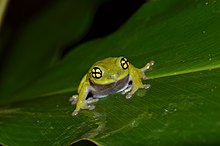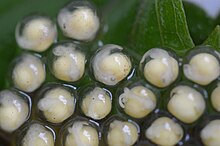Raorchestes – Wikipedia
From Wikipedia, the free encyclopedia
Genus of amphibians


Raorchestes is a genus of frogs in the subfamily Rhacophorinae[2] that are found in mountainous regions of South Asia, Southeast Asia, and southern China.[3] A recent study places Raorchestes as a sister taxon of Pseudophilautus.[2][4] Before the description of the genus in 2010, species now in Raorchestes had been assigned to genera Ixalus (no longer recognized), Philautus, and Pseudophilautus.[2]
The genus is named in honour of C. R. Narayan Rao in recognition of his contribution to Indian batrachology.[3] The other root orchestes is based on an older genus name for frogs of the Philautus group, Orchestes Tschudi 1838.[5] Extensive exploration in the range of the genus in the Western Ghats of India suggests an under-estimation of the number of species in the genus.[6][7][8] A study of the diverse species of the genus show that the separate isolated massifs of the Western Ghats played a major role in the speciation and habitat specificity seen in the genus of bush frogs.[7]
Description[edit]


Raorchestes are largely nocturnal, relatively small frogs with adult body size 15–45 mm (0.6–1.8 in) in snout-vent length. They lack vomerine teeth. Males have a large transparent vocal sac while calling. All described species of Raorchestes thus far, show direct development, that is, their life cycle does not involve a free-swimming tadpole stage.[9] Their eggs hatch-out froglets skipping the tadpole stage making them less dependent on water.[9]Raorchestes tinniens eggs took 36 days to hatch and temperature played a huge role in the development times.[10] Different individuals of a species within this genus can be difficult to identify in the field because of color and pattern variations.[6] Species of the genus Raorchestes also have different variations in their iris and pupil coloration.[3] Difficulties in field identifications are leading to more integrative species description practices within the genus.[11] These difficulties have also led to potential misidentification of species and ranges.[12]
Frogs of the genus Raorchestes are known as bush frogs, and are known to use different arboreal niches.[7] The exception being the short-limbed Raorchestes resplendens that is known to be ground-dwelling and was discovered on the highest peak of the Western Ghats called Anamudi.[13]
Distribution[edit]
One group is found in the mountain ranges of southern India (in the Western and Eastern Ghats) and another group ranges from northeastern India to Nepal, Myanmar, Thailand, and Laos to southern China and Vietnam and Peninsular Malaysia.[3] They are most diverse in the Western Ghats of India; in contrast, only eight species from the genus have been reported from southeast Asia and China.[3][12][14]

Conservation[edit]
IUCN has assessed 38 species of Raorchestes. Many species are Critically Endangered, and one species (Raorchestes travancoricus) was already considered extinct,[15] only to be rediscovered in 2004.[15][3][16] Of the 38, eight are data deficient and 23 are in the critically endangered, endangered, and vulnerable categories.[15] The Amphibian Specialist Group’s list of “lost frogs” (frogs not seen for decades) includes 10 Raorchestes species.[16] Since several species of the genus have been described in the last 15 years conservation data is relatively poor as are detailed life-history studies.[3][6][11] Several species of the genus are known to have very narrow distribution ranges and are tied to specific niches in the environment which makes it difficult to have blanket conservation policy for the genus.[7][13]
Several species of Raorchestes have been reported in checklists generated from both protected areas, as well as, agro and plantation landscapes.[17][18]
Species[edit]
Many new species from India have been described since 2000.[19][20] The following species are currently recognised in the genus Raorchestes:.[2]
- Raorchestes agasthyaensis Zachariah et al., 2011
- Raorchestes akroparallagi (Biju and Bossuyt, 2009)
- Raorchestes andersoni (Ahl, 1927)
- Raorchestes anili (Biju and Bossuyt, 2006)
- Raorchestes annandalii (Boulenger, 1906)
- Raorchestes archeos Vijayakumar, Dinesh, Prabhu, and Shanker, 2014
- Raorchestes aureus Vijayakumar, Dinesh, Prabhu, and Shanker, 2014
- Raorchestes beddomii (Günther, 1876)
- Raorchestes blandus Vijayakumar, Dinesh, Prabhu, and Shanker, 2014
- Raorchestes bobingeri (Biju and Bossuyt, 2005)
- Raorchestes bombayensis (Annandale, 1919)
- Raorchestes cangyuanensis Wu, Suwannapoom, Xu, Murphy, and Che, 2019
- Raorchestes chalazodes (Günther, 1876)
- Raorchestes charius (Rao, 1937)
- Raorchestes chlorosomma (Biju and Bossuyt, 2009)
- Raorchestes chotta (Biju and Bossuyt, 2009)
- Raorchestes chromasynchysi (Biju and Bossuyt, 2009)
- Raorchestes coonoorensis (Biju and Bossuyt, 2009)
- Raorchestes crustai Zachariah et al., 2011
- Raorchestes dubois (Biju and Bossuyt, 2006)
- Raorchestes drutaahu Garg, Suyesh, Das, Bee and Biju, 2021
- Raorchestes echinatus Vijayakumar, Dinesh, Prabhu, and Shanker, 2014
- Raorchestes flaviocularis Vijayakumar, Dinesh, Prabhu, and Shanker, 2014
- Raorchestes flaviventris (Boulenger, 1882)
- Raorchestes ghatei Padhye, Sayyed, Jadhav, and Dahanukar, 2013
- Raorchestes glandulosus (Jerdon, 1854)
- Raorchestes graminirupes (Biju and Bossuyt, 2005)
- Raorchestes griet (Bossuyt, 2002)
- Raorchestes gryllus (Smith, 1924)
- Raorchestes hassanensis Dutta, 1985
- Raorchestes hillisi Jiang et al., 2020
- Raorchestes honnametti Gururaja,Priti, Roshmi, and Aravind, 2016
- Raorchestes huanglianshan Jiang et al., 2020
- Raorchestes indigo Vijayakumar, Dinesh, Prabhu, and Shanker, 2014
- Raorchestes jayarami (Biju and Bossuyt, 2009)
- Raorchestes johnceei Zachariah et al., 2011
- Raorchestes kadalarensis Zachariah et al., 2011
- Raorchestes kaikatti (Biju and Bossuyt, 2009)
- Raorchestes kakachi Seshadri, Gururaja, and Aravind, 2012
- Raorchestes kakkayamensis Garg, Suyesh, Das, Bee and Biju, 2021
- Raorchestes keirasabinae Garg, Suyesh, Das, Bee and Biju, 2021
- Raorchestes kollimalai Gowande, Ganesh, and Mirza, 2020
- Raorchestes lechiya Zachariah et al., 2016
- Raorchestes leucolatus Vijayakumar, Dinesh, Prabhu, and Shanker, 2014
- Raorchestes longchuanensis (Yang and Li, 1978)
- Raorchestes luteolus (Kuramoto and Joshy, 2003)
- Raorchestes manipurensis (Mathew and Sen, 2009)
- Raorchestes manohari Zachariah et al., 2011
- Raorchestes marki (Biju and Bossuyt, 2009)
- Raorchestes menglaensis (Kou, 1990)
- Raorchestes munnarensis (Biju and Bossuyt, 2009)
- Raorchestes nerostagona (Biju and Bossuyt, 2005)
- Raorchestes ochlandrae (Gururaja et al., 2007)
- Raorchestes parvulus (Boulenger, 1893)
- Raorchestes ponmudi (Biju and Bossuyt, 2005)
- Raorchestes primarrumpfi Vijayakumar, Dinesh, Prabhu, and Shanker, 2014
- Raorchestes ravii Zachariah et al., 2011
- Raorchestes resplendens Biju, Shouche, Dubois, Dutta, and Bossuyt, 2010
- Raorchestes rezakhani Al-Razi, Maria, and Muzaffar, 2020
- Raorchestes sahai (Sarkar and Ray, 2006)
- Raorchestes sanctisilvaticus (Das and Chanda, 1997)
- Raorchestes sanjappai Garg, Suyesh, Das, Bee and Biju, 2021
- Raorchestes shillongensis (Pillai and Chanda, 1973)
- Raorchestes signatus (Boulenger, 1882)
- Raorchestes silentvalley Zachariah, Cyriac et al., 2016
- Raorchestes sushili (Biju and Bossuyt, 2009)
- Raorchestes theuerkaufi Zachariah et al., 2011
- Raorchestes thodai Zachariah et al., 2011
- Raorchestes tinniens (Jerdon, 1854)
- Raorchestes travancoricus (Boulenger, 1891)
- Raorchestes tuberohumerus (Kuramoto and Joshy, 2003)
- Raorchestes uthamani Zachariah et al., 2011
- Raorchestes vellikkanan Garg, Suyesh, Das, Bee and Biju, 2021
References[edit]
- ^ Biju, S. D.; Yogesh Shouche; Alain Dubois; S. K. Dutta; Franky Bossuyt (2010). “A ground-dwelling rhacophorid frog from the highest mountain peak of the Western Ghats of India” (PDF). Current Science. 98 (8): 1119–1125.
- ^ a b c d Frost, Darrel R. (2014). “Raorchestes Biju, Shouche, Dubois, Dutta, and Bossuyt, 2010″. Amphibian Species of the World: an Online Reference. Version 6.0. American Museum of Natural History. Retrieved 3 July 2014.
- ^ a b c d e f g Biju, S. D.; Bossuyt, F. (2009). “Systematics and phylogeny of Philautus Gistel, 1848 (Anura, Rhacophoridae) in the Western Ghats of India, with descriptions of 12 new species”. Zoological Journal of the Linnean Society. 155 (2): 374–444. doi:10.1111/j.1096-3642.2008.00466.x.
- ^ Alexander Pyron, R.; Wiens, John J. (2011). “A large-scale phylogeny of Amphibia including over 2800 species, and a revised classification of extant frogs, salamanders, and caecilians”. Molecular Phylogenetics and Evolution. 61 (2): 543–583. doi:10.1016/j.ympev.2011.06.012. PMID 21723399.
- ^ Tschudi, Johann Jakob von; Agassiz, Louis (1838). Classification der Batrachier : mit Berucksichtigung der fossilen Thiere dieser Abtheilung der Reptilien / von J. J. Tschudi. Neuch©Øtel. doi:10.5962/bhl.title.4883.
- ^ a b c Vijayakumar, S. P.; Dinesh, K. P.; Prabhu, Mrugank V.; Shanker, Kartik (2014-12-10). “Lineage delimitation and description of nine new species of bush frogs (Anura: Raorchestes , Rhacophoridae) from the Western Ghats Escarpment”. Zootaxa. 3893 (4): 451–488. doi:10.11646/zootaxa.3893.4.1. ISSN 1175-5334. PMID 25544534.
- ^ a b c d Vijayakumar, S. P.; Menezes, Riya C.; Jayarajan, Aditi; Shanker, Kartik (2016-08-17). “Glaciations, gradients, and geography: multiple drivers of diversification of bush frogs in the Western Ghats Escarpment”. Proceedings of the Royal Society B: Biological Sciences. 283 (1836): 20161011. doi:10.1098/rspb.2016.1011. PMC 5013767. PMID 27534957.
- ^ Priti, H.; Roshmi, Rekha Sarma; Ramya, Badrinath; Sudhira, H. S.; Ravikanth, G.; Aravind, Neelavara Anantharam; Gururaja, Kotambylu Vasudeva (2016-03-02). “Integrative Taxonomic Approach for Describing a New Cryptic Species of Bush Frog (Raorchestes: Anura: Rhacophoridae) from the Western Ghats, India”. PLOS ONE. 11 (3): e0149382. Bibcode:2016PLoSO..1149382P. doi:10.1371/journal.pone.0149382. ISSN 1932-6203. PMC 4774957. PMID 26934213.
- ^ a b Meegaskumbura, Madhava; Senevirathne, Gayani; Biju, S. D.; Garg, Sonali; Meegaskumbura, Suyama; Pethiyagoda, Rohan; Hanken, James; Schneider, Christopher J. (2015). “Patterns of reproductive-mode evolution in Old World tree frogs (Anura, Rhacophoridae)”. Zoologica Scripta. 44 (5): 509–522. doi:10.1111/zsc.12121. S2CID 21720173.
- ^ “Development of endemic Nilgiri Bush Frog, Raorchestes tinniens (Jerdon, 1853) (Anura, Rhacophoridae) in the Nilgiris, Western Ghats, India”. ISSCA. Retrieved 2020-02-25.
- ^ a b Priti, H.; Roshmi, Rekha Sarma; Ramya, Badrinath; Sudhira, H. S.; Ravikanth, G.; Aravind, Neelavara Anantharam; Gururaja, Kotambylu Vasudeva (2016-03-02). Joger, Ulrich (ed.). “Integrative Taxonomic Approach for Describing a New Cryptic Species of Bush Frog (Raorchestes: Anura: Rhacophoridae) from the Western Ghats, India”. PLOS ONE. 11 (3): e0149382. Bibcode:2016PLoSO..1149382P. doi:10.1371/journal.pone.0149382. ISSN 1932-6203. PMC 4774957. PMID 26934213.
- ^ a b Yu, Guohua; Liu, Shuo; Hou, Mian; Li, Song; Yang, Junxing (2019-04-05). “Extension in distribution of Raorchestes parvulus (Boulenger, 1893) (Anura: Rhacophoridae) to China”. Zootaxa. 4577 (2): 381–391. doi:10.11646/zootaxa.4577.2.10. ISSN 1175-5334. PMID 31715729. S2CID 133261512.
- ^ a b Biju, S. D.; Shouche, Yogesh; Dubois, Alain; Dutta, S. K.; Bossuyt, Franky (2010). “A ground-dwelling rhacophorid frog from the highest mountain peak of the Western Ghats of India”. Current Science. 98 (8): 1119–1125. ISSN 0011-3891. JSTOR 24111771.
- ^ “AmphibiaWeb — Search Results”. amphibiaweb.org. Retrieved 2021-03-25.
- ^ a b c IUCN (2014). “IUCN Red List of Threatened Species. Version 2014.1.
“ . Retrieved 3 July 2014. - ^ a b Amphibian Specialist Group (2013). “Lost frogs”. Retrieved 15 July 2013.
- ^ Handbook of climate change and biodiversity. Leal Filho, Walter,, Barbir, Jelena,, Preziosi, Richard. Cham, Switzerland. 2018-08-28. ISBN 978-3-319-98681-4. OCLC 1050437289.
{{cite book}}: CS1 maint: others (link) - ^ Murali, R.; Raman, T. R. S. (2012-08-26). “CEPF Western Ghats Special Series : Streamside amphibian communities in plantations and a rainforest fragment in the Anamalai hills, India”. Journal of Threatened Taxa: 2849–2856. doi:10.11609/JoTT.o2829.2849-56. ISSN 0974-7907.
- ^ Manoj, E. M. (August 7, 2011). “New species of frogs found in Western Ghats”. The Hindu. Retrieved 26 September 2014.
- ^ “26 new species of frogs and insects discovered in India”. Hindustan Times. June 15, 2009. Archived from the original on October 6, 2014. Retrieved 27 September 2014.
Recent Comments